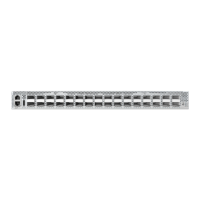G
LOSSARY
– 1128 –
DHCP SNOOPING A technique used to enhance network security by snooping on DHCP server
messages to track the physical location of hosts, ensure that hosts only use
the IP addresses assigned to them, and ensure that only authorized DHCP
servers are accessible.
DIFFSERV Differentiated Services provides quality of service on large networks by
employing a well-defined set of building blocks from which a variety of
aggregate forwarding behaviors may be built. Each packet carries
information (DS byte) used by each hop to give it a particular forwarding
treatment, or per-hop behavior, at each network node.
DiffServ allocates
different levels of service to users on the network with mechanisms such as
traffic meters, shapers/droppers, packet markers at the boundaries of the
network.
DNS Domain Name Service. A system used for translating host names for
network nodes into IP addresses.
DSCP Differentiated Services Code Point Service. DSCP uses a six-bit tag to
provide for up to 64 different forwarding behaviors. Based on network
policies, different kinds of traffic can be marked for different kinds of
forwarding. The DSCP bits are mapped to the Class of Service categories,
and then into the output queues.
EAPOL Extensible Authentication Protocol over LAN. EAPOL is a client
authentication protocol used by this switch to verify the network access
rights for any device that is plugged into the switch. A user name and
password is requested by the switch, and then passed to an authentication
server (e.g., RADIUS) for verification. EAPOL is implemented as part of the
IEEE 802.1X Port Authentication standard.
EUI Extended Universal Identifier is an address format used by IPv6 to identify
the host portion of the network address. The interface identifier in EUI
compatible addresses is based on the link-layer (MAC) address of an
interface. Interface identifiers used in global unicast and other IPv6
address types are 64 bits long and may be constructed in the EUI-64
format. The modified EUI-64 format interface ID is derived from a 48-bit
link-layer address by inserting the hexadecimal number FFFE between the
upper three bytes (OUI field) and the lower 3 bytes (serial number) of the
link layer address. To ensure that the chosen address is from a unique
Ethernet MAC address, the 7th bit in the high-order byte is set to 1
(equivalent to the IEEE Global/Local bit) to indicate the uniqueness of the
48-bit address.

